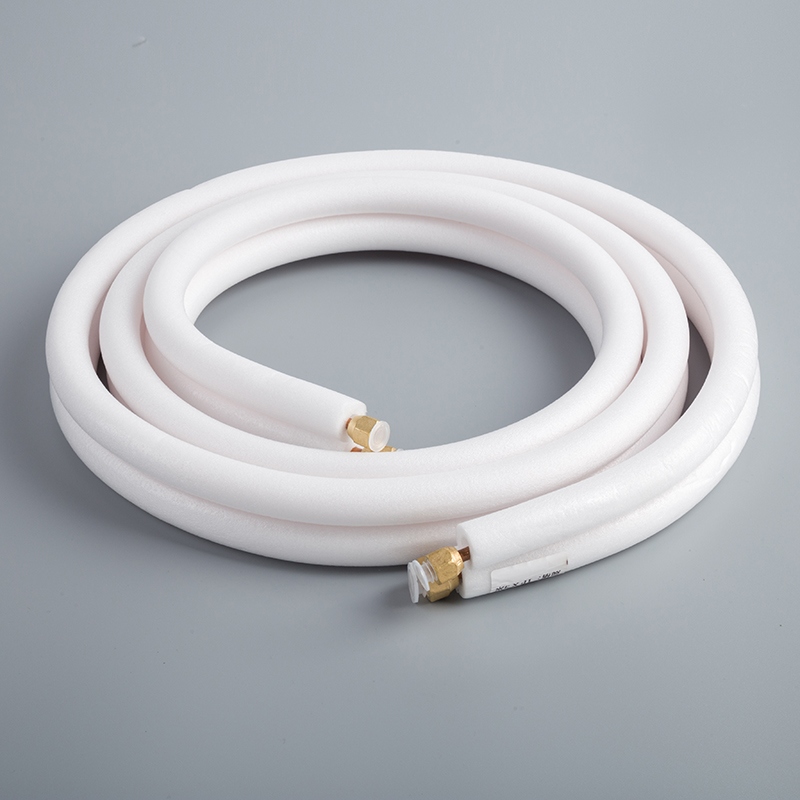Understanding Copper Pipe Sizes for Split AC Systems in 2025

Choosing the right standard size copper pipe for split aircon is very important. In 2025, common copper pipe sizes are 1/4 inch to 1/2 inch. The size depends on how powerful the AC unit is. Using the wrong standard size copper pipe for split aircon can cause problems. The AC might not cool well, repairs could cost more, and it may not last as long. A small pipe blocks refrigerant flow, while a big one wastes energy. Picking the correct standard size copper pipe for split aircon helps your AC work better, saves money, and keeps you comfortable.
Key Takeaways
Picking the right copper pipe size is very important. It helps your split AC cool well and avoids expensive fixes.
The right pipe size uses less energy. Proper refrigerant flow makes your AC work easier, cutting electricity costs.
Copper pipes should match your AC's refrigerant type. This stops leaks and keeps your AC running safely.
Plan the setup carefully. Avoid sharp turns and follow the maker's instructions for good refrigerant flow.
Check the insulation on copper pipes often. Good insulation saves energy and keeps the pipes safe from harm.
Why Copper Pipe Size Is Important
How It Affects Refrigerant Flow
Copper pipes move refrigerant between the inside and outside AC units. The pipe size changes how easily refrigerant flows. Small pipes send refrigerant to the cooling coils. If the pipe is too small, refrigerant flow slows down, making cooling less effective. Big pipes return refrigerant to the compressor. These pipes must be the right size to stop leaks and keep refrigerant moving well. Picking the correct size helps your AC cool properly.
How It Impacts Energy Use
Copper pipe size affects how much energy your AC uses. Smooth refrigerant flow means the system works less to cool your home. Big pipes waste energy because they need more refrigerant. Small pipes make the compressor work harder, using more energy. Choosing the right pipe size helps your AC save energy and lower your bills.
How It Helps Your AC Last Longer
Wrong pipe sizes can damage your AC over time. Small pipes can overheat the compressor by slowing refrigerant flow. Big pipes can cause refrigerant to move incorrectly, wearing out parts faster. Correct pipe sizes keep refrigerant flowing evenly, protecting the compressor and other parts. This makes your AC last longer and avoids expensive repairs.
Standard Size Copper Pipe for Split Aircon Systems
Common Sizes (e.g., 1/4 inch, 3/8 inch, 1/2 inch)
Copper pipes for split AC systems come in different sizes. The most popular ones are:
1/4 inch
3/8 inch
1/2 inch
These sizes work well with most split AC units. Smaller systems often use the 1/4-inch pipe. Larger units usually need 3/8-inch or 1/2-inch pipes. Picking the right size helps your AC cool better and run smoothly.
Tip: Always follow the manufacturer’s guide for the standard size copper pipe for split aircon systems. This ensures your AC works properly.
Applications of Each Size in Split AC Systems
Each copper pipe size has a specific job in split AC systems:
1/4 inch: Best for small AC units in small rooms or offices. It is often used for the liquid line, which moves refrigerant from the outdoor unit to the indoor unit.
3/8 inch: Fits medium-sized systems. It is commonly used for the suction line, which sends refrigerant back to the compressor.
1/2 inch: Made for large AC units in big homes or businesses. This size is used for systems with higher cooling needs.
Using the correct copper pipe size keeps refrigerant flowing well. It also avoids problems like leaks or poor cooling.
Compatibility with Modern Refrigerants
Modern split AC systems use eco-friendly refrigerants like R-32 and R-410A. These refrigerants work at higher pressures than older ones. Copper pipes must handle this pressure without breaking or leaking.
Copper is strong, long-lasting, and resists rust. It stays sturdy under high pressure, making it perfect for today’s AC systems. When choosing a standard size copper pipe for split aircon systems, make sure it matches the refrigerant in your unit. This ensures safe and efficient cooling.
Note: Using the wrong copper pipes can cause leaks, poor cooling, and expensive repairs. Always check compatibility before installing.
Factors to Think About When Picking Copper Pipe for Split AC
System Size and Cooling Needs
Your AC’s size decides the copper pipe needed. Bigger systems need pipes for more refrigerant. Smaller systems work fine with smaller pipes. Match the pipe size to your AC’s cooling needs. Cooling needs mean how much heat your AC removes.
For example, a small bedroom with a 1-ton AC might need 1/4-inch pipes. A big living room with a 2-ton AC may need 3/8-inch or 1/2-inch pipes. Wrong pipe sizes can waste energy or cool poorly. Always check your AC’s cooling power before picking pipes.
Tip: Look at your AC manual or ask a technician to find the right pipe size.
Refrigerant Type Used
Modern ACs use eco-friendly refrigerants like R-32 or R-410A. These refrigerants work under higher pressure than older ones. Copper pipes must be strong to handle this pressure. Thin or weak pipes might leak or break over time.
Each refrigerant flows differently. For example, R-32 needs exact pipe sizes for smooth flow. Wrong pipe sizes can lower cooling and use more energy.
When choosing copper pipes, check if they match your AC’s refrigerant. This keeps your AC safe and working well.
Note: Not sure about refrigerant compatibility? Ask an HVAC expert for help.
Installation Distance and Design
The space between indoor and outdoor units affects pipe choice. Longer distances need bigger pipes for good refrigerant flow. Small pipes might not let refrigerant reach the indoor unit.
The design of the setup also matters. Sharp turns or long vertical pipes can slow refrigerant flow. Pick pipes that handle these challenges without problems.
Most AC makers give rules for pipe lengths. Follow these to keep your AC efficient and avoid leaks or damage.
Reminder: Plan your setup to reduce bends and pick the right pipe size. This helps your AC work better and last longer.
Recommended Copper Pipe Lengths for Split AC Systems
Maximum and Minimum Lengths
The length of copper pipes is very important for AC performance. Manufacturers give guidelines for the standard pipe length for split AC systems. These guidelines help refrigerant move smoothly between indoor and outdoor units.
The shortest pipe length is usually about 10 feet. This stops refrigerant from returning too fast to the compressor. The longest pipe length can be between 50 and 100 feet, depending on the AC model. Going over this limit can make cooling less effective. Always check your AC manual for the right pipe lengths.
Impact of Length on System Performance
Copper pipe length affects how well your AC works. Short pipes let refrigerant flow quickly, helping the AC cool better. But very short pipes can make refrigerant return too fast, harming the compressor.
Long pipes are needed for some setups but can slow refrigerant flow. This makes the AC work harder and use more energy. To keep your AC working well, match the pipe length to your AC’s cooling power and setup.
Risks of Incorrect Pipe Lengths
Using pipes that are too long or too short can cause problems. Short pipes may overheat refrigerant, which can damage the compressor. Long pipes can cause leaks or make cooling less effective.
Wrong pipe lengths also waste energy. Your AC will have trouble keeping the room cool, raising electricity costs. To avoid these issues, follow the manufacturer’s pipe length rules. Asking a professional can also help you choose the right length.
Tip: Plan pipe lengths carefully during installation to keep your AC working well and lasting longer.
Best Practices for Installing Copper Pipe for Split AC
Ensuring Leak-Free Connections
Leak-free connections help your split AC work well. Use good-quality tools and fittings when connecting copper pipes. Make sure the pipe ends are smooth and clean. Rough edges can cause leaks by leaving gaps. Tighten the fittings carefully, but don’t over-tighten them. Over-tightening can break the pipe.
Use sealing materials like Teflon tape or thread sealant for secure connections. Follow the manufacturer’s instructions to tighten fittings just right. Leak-free connections stop refrigerant loss, keep cooling strong, and save on repairs.
Tip: Test for leaks after installation with a pressure gauge or soap solution. This ensures everything is sealed before using the AC.
Proper Insulation and Protection
Insulating copper pipes saves energy and keeps the system efficient. Cover the pipes with foam or rubber sleeves for insulation. This stops heat transfer and prevents condensation, which can cause water damage or mold.
Protect pipes from damage by securing them with brackets or clamps. Don’t place pipes in areas with direct sunlight or bad weather. If pipes must be outside, use UV-resistant insulation to protect them. Good insulation and protection make your AC last longer and work better.
Reminder: Check insulation often for wear or damage. Replace damaged insulation quickly to keep your AC running well.
Avoiding Common Installation Errors
Mistakes during installation can hurt your AC’s performance. One mistake is using the wrong pipe size. Small pipes block refrigerant flow, and big pipes waste money without helping. Always match the pipe size to your AC’s needs.
Another mistake is poor pipe routing. Avoid sharp bends or long pipe runs, as these slow refrigerant flow. Plan the layout to reduce bends and keep refrigerant moving smoothly.
Skipping the manufacturer’s instructions is another common error. Follow their rules for pipe size, length, and setup to avoid problems. Careful planning and following guidelines help your AC work well and last longer.
Note: If you’re unsure about installation, ask a professional for help. Expert advice can prevent costly mistakes.
Picking the correct copper pipe size helps your AC cool well. It also lowers energy costs and makes your unit last longer. Right pipe sizes stop problems like leaks or system damage. Asking an expert can prevent errors and ensure pipes fit your AC. During installation, use insulation and check for leaks to keep it working. These steps give you dependable cooling and less worry for years.
FAQ
What happens if I use the wrong copper pipe size for my split AC?
Using the wrong pipe size can cause cooling problems. Small pipes slow refrigerant flow, and large pipes waste energy. Both can harm your AC over time.
Tip: Follow the manufacturer’s guide to pick the right pipe size.
Can I reuse old copper pipes for a new split AC system?
Reusing old pipes can be unsafe. They might not fit the refrigerant or pressure needs of modern ACs. Old pipes may also have dirt or damage that lowers performance.
Note: Installing new pipes is safer and keeps your AC efficient.
How do I know the correct pipe length for my AC?
Your AC manual lists the best pipe lengths to use. These lengths help refrigerant flow properly and keep your AC working well.
Reminder: If unsure, ask an HVAC expert to measure and plan.
Do copper pipes need insulation?
Yes, insulation stops heat transfer and prevents condensation. It saves energy and protects the pipes from damage. Foam or rubber sleeves work best for insulation.
Emoji Tip: 🛠️ Check insulation often and replace it if worn out.
Can I install copper pipes for my split AC myself?
Installing pipes yourself is not a good idea. Wrong pipe sizes, bad connections, or poor setup can damage your AC.
Advice: Hire a trained technician to avoid mistakes and costly repairs.
See Also
Understanding Copper Pipe Dimensions: An In-Depth Overview
The Impact of Pure Copper Pipes on AC Systems
A Complete Guide to Accurately Measuring Copper Pipe Size


